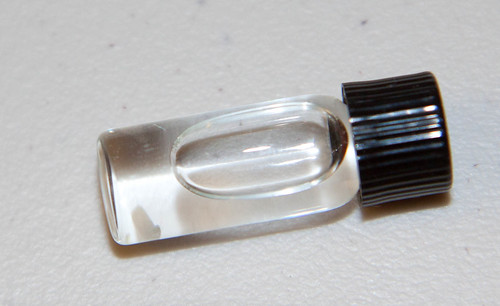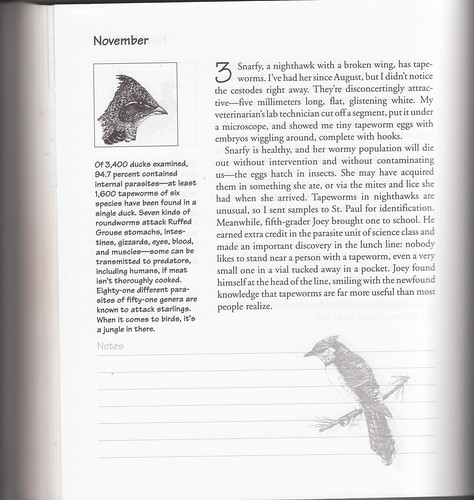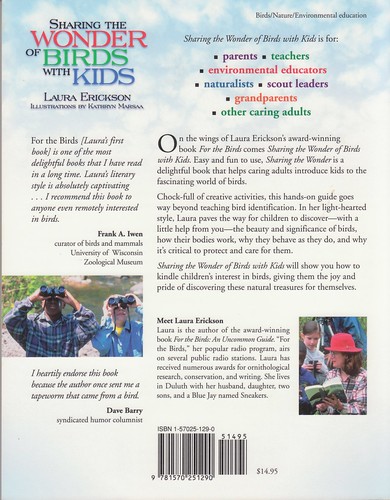Little by little, I'm digitizing all the old "For the Birds" transcripts that I can still find. I produced quite a few programs over the past 34 years, and as of the moment I'm writing this, transcripts are available for 2,882 of them. One of the ones I just found, from October 12, 1992, was about a disturbing discovery I had just made about one of the nighthawks I was rehabilitating. I'll quote it as I originally wrote it.
Last week, I made a startling discovery. One of my nighthawks, the one I call Snarfy, has tapeworms. I hadn't spent a lot of time looking at droppings as I clean up the newspapers every day, but all of a sudden I noticed a suspicious and repulsive white thing and brought it in for my veterinarian's technician to check out. She cut off a segment and looked under the microscope and voila! There were tiny tapeworm eggs, with the tapeworm embryos wiggling around, complete with hooks.Fortunately, Snarfy has maintained a very good weight and seems comfortable and in good health. And, even more fortunately, bird tapeworms have an indirect host lifestyle. The eggs simply cannot hatch in a bird or mammal. Some species depend on insects and some on earthworms to be their host when hatching. They cannot reach maturity in an insect and they cannot hatch and survive their first life stages in a bird. Snarfy must have gotten hers from an infested insect that she ate in the wild, and according to the authorities, she cannot pass the tapeworms to my other nighthawks, Sneakers the Blue Jay, my dog, my cat, my children, or me. Of course, none of those authorities are giving me any guarantees. I'm not sure how long tapeworms live, but eventually they should all complete their natural lives and die even without treating her.It must be singularly unpleasant to have a tapeworm hooked to your innards. I've never before had a nighthawk with the problem, and so far I haven't been able to find any information in the literature about parasites in the nighthawk family. But tapeworms are a major problem in some bird families. One tapeworm with earthworms as intermediates infests robins, several different tapeworms affect ducks, and fish-eating birds are especially vulnerable to a variety of tapeworms.Ornithologists and invertebrate biologists are interested in tapeworms because certain groups of birds contain their own particular species. Some taxonomists can determine avian relationships and how long ago species diverged by the kinds of intestinal parasites they have, and tapeworms, or cestodes, are particularly helpful in this regard.Naturally, whenever I see something new in one of my birds, I have to research it all out, which leads me down unexpected pathways. It turns out that there are more unpleasant creatures living inside birds than I would ever have imagined. A survey of 3,400 ducks in Washington showed that 94.7 percent of them contained internal parasites. As many as 1,600 tapeworms of six different species have been found in a single duck. Seven different kinds of roundworms attack Ruffed Grouse in their stomach, intestines, gizzard, eyes, blood, or muscles. Apparently, some of these can be transmitted to predators, including humans, if partridge meat isn't thoroughly cooked. Everyday starlings have been reported to carry at least 81 different parasites of 51 different genera.All in all, when it comes to birds, it's not only a jungle out there—it's a jungle IN there. Walt Disney's classic short animated feature was right. "It's Tough to Be a Bird."
This transcript was the basis of the November 3 entry in my first book, For the Birds: An Uncommon Guide.
That was the page Dave Barry referred to when he wrote a very nice recommendation for the book.
I thanked him with an appropriate gift, and he was nice enough to write a cover blurb for my next book, Sharing the Wonder of Birds with Kids!



